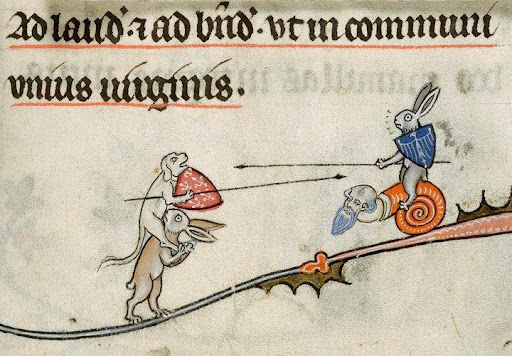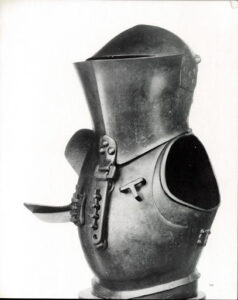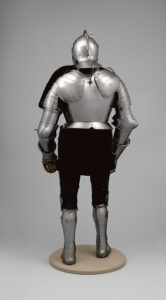Honor and Defense
Tournament Armor in the Late Medieval Ages
by Helena von Sadovszky
Chivalric tournaments and contests were a form of battlefield, in which armor played a significant role. Largely because armor was a symbol of chivalry and functionality intertwined with what it meant to be a knight. ‘L’arnès del cavalier’ (The Knight’s Harness, composed c. 1370-1413) by Père March, “imputes symbolic values to every piece of the knight’s harness, from head to toe” (Fallows 28). “For example, the bascinet symbolizes humility, since it protects the head from pride, the gauntlets symbolize largesse, for they protect the hands from avarice, and the spurs symbolize the knight’s perseverance on the road to paradise” (Fallows 28).
The tournaments themselves were important because a significant part of the chivalric code was public honor; and in the medieval world honor was won through public deeds of valor, such as tournaments or notable acts in war. However, during the fifteenth century, the ideals of chivalry found less place on the battlefield; thus, they were transferred to the tourney field (Edge 98). By this time the tenets of the code had become illusory, and largely restricted to the opulent splendor of tournaments and noble circles. They no longer had any application in warfare as demonstrated by the treatment of civilians; Henry V, who is commonly remembered as one of the most chivalric and honorable kings, allowed for women and children to starve during sieges and the killing of unarmed prisoners by (Edge 98).
In the joust, one’s abilities, actions, successes, and failures were closely scrutinized in order to award points. “Loss of composure at the crucial moment of impact was always embarrassingly obvious” (Fallows 7). “From both a physical and symbolic point of view jousts offered tangible evidence of a man’s prowess, of the meaningful role that he played in the masculine active life and of his rejection of a life of sloth or recreance” (Fallows 8). Masculinity and the refusal to show fear were important elements of chivalry and one’s social honor.
While the tournament provided a less chaotic environment for advancing one’s honor, it was no less dangerous. The word ‘tournament’ originally referred to mêlée events fought between teams of mounted knights, each armed with a sword or club. “The idea was to fight the other team until a halt was called”. These were in style from the twelfth to mid-fourteenth century (Fallows 2). They provided a means to further one’s political agenda and settle old scores (Fallows 2). This is likely one of the reasons for their decline in popularity. Some participants stood on the periphery (they were there to make an appearance) while others “desultorily pursued, ambushed, thwacked and cudgeled their victims” (Fallows 3). Until the thirteenth century, jousts served as “opening acts” or sideshows for the main event of the mêlée tournament. This form of competition grew more popular as many knights began to prefer one-on-one competition (Fallows 7).

By the fourteenth century, the joust had superseded the mêlée in popularity, ‘tournaments’ included a wide variety of chivalric deeds (such as horse racing), and jousts became a central sporting activity (Fallows 7). This was partially due to the lack of space jousts took up compared to team combat. And new armor developments allowed for “greater technical virtuosity with the lance” (Fallows 7). The motif of jousting is depicted in medieval marginalia (figure 1), and the combatants are not always human. This demonstrates the symbolic importance and popularity of jousting.

When examining the equipment used during the joust, it is important to remember that jousting armor fundamentally evolved from battlefield armor. That being said, jousting armor tended to be thicker and stronger than battle armor due to the fact that they knew they were taking blows and could sacrifice weight and maneuverability to an extent. During the joust, the knight would be on horseback the entire time- he would not be bearing his own weight. Also, the knight would likely have attendants to help him into his kit and possibly even onto his horse, so he would not have to climb. And finally, because of widespread jousting techniques, the knight could be confident that his opponent was aiming for his chest rather than his legs; this allowed him to focus more on arming his torso rather than his lower extremities. Consequently, rudimentary reinforcing breastplates (figure 2) were worn over the principal breastplate; this was secured by a series of clasps. These breastplates varied widely in quality (Fallows 79). The backplates (figure 3) were shallower (Fallows 79). This was probably due to the unlikelihood of a knight being struck in the back; thus, amor on the back did not require the same level of protection as one’s chest. However, a structured backplate, however shallow, would have braced the torso when the wearer was struck by the lance. This would have helped the rider remain upright, avoiding defeat and embarrassment.

Much of the armor was in the Italian export style, meaning that it was made by Italian armorers with the sole purpose of exportation (Fallows 85). It was often made in the style (or at least using some of the techniques) of the fashion worn in the particular country it was being exported to. This contributed to the exchange of design and decorative techniques and helped establish the Italian armorers’ supremacy in Europe. Naturally there were some slight variations between sets of jousting armor. For example, different types of gauntlet defenses were worn. Commonalities between the types include a more heavily armored and less articulated left hand, which was more susceptible to injury due to the fact that it traditionally held the shield (one of the targets). Furthermore, the right hand needed more flexibility in order to wield a sword or lance (Fallows 86). It is unlikely that allowances were made for left-handed knights due to the widespread structure of tournaments and the medieval tendency to perceive left-handedness as ungodly; it is likely that even naturally left-handed knights would have trained themselves to carry the lance in their right hand. Forms of shoulder defenses also varied, particularly for the left side, however it usually consisted of a combination of more specialized pauldrons and rondels. This extra protection on the left side was particularly important as fighting and jousting without shields was not uncommon.

By the late fifteenth century, the frog-mouthed helm (figure 4) was worn exclusively in jousts and never in battle (Fallows 95). Figure 4 is a frog-mouthed helm belonging to Maximilian I. As can be seen there is a trapdoor opening used for ventilation purposes on the right side of the face (the side of the knight facing away from the oncoming lance and ensuing splinters). This helmet features decorative etching reminiscent of a Gothic cathedral. This helmet would have been attached to the cuirass via a series of pegs (Fallows 95).
During jousts, some knights wore jupons (a form of cloth armor also known as ‘coat armor’) or surcoats over breastplates- these were often embroidered with a symbolic device. These aided in the identification of the combatants (Fallows 80).
Some of the fundamental similarities and differences between tournament and battlefield armor can be defined quite readily, although with changes over time. In the fifteenth century especially, Italian style armor or export armor was popular. Many of the general defenses remained- however, jousting armor did appear to have more armor concentrated on the left side. This was something battlefield armor also saw in the fifteenth-sixteenth centuries. Jousting armor also had reinforced breastplates, something that was not seen in war armor. This was due to the increased weight allowance of jousting as well as the known target area. Combat armor was designed to withstand attacks from all sides, thus the strength of the backplate was not sacrificed in order to bolster the breast plate. These principles are reflected in the helmets; jousting helms are designed to withstand heavy blows, and sacrifice visibility. By contrast, combat helms are smaller and designed to deflect blows but allow for good visibility, especially peripheral vision, as seen in the bascinet. There is also an emphasis on plate armor when jousting: brigandines and plain mail were not worn alone.
Overall, as the Middle Ages progressed, the tournament grew to encapsulate more and more of the chivalric values that had once been relegated to the battlefield. This was largely driven by the progression of technology which left little room for knights and untrained armies. The most important events at the tournament were the mêlée and later the joust, both of which allowed the knight to demonstrate his masculinity and martial prowess to the court in a more palatable manner. This tradition has continued throughout human history from events held in the colosseum to those held in Selby Stadium today.
Sources
Edge, David, and John Miles Paddock. Arms & Armor of the Medieval Knight: an Illustrated History of Weaponry in the Middle Ages. New York: Crescent Books, 1996.
Fallows, Noel. Jousting in Medieval and Renaissance Iberia. Woodbridge: Boydell Press, 2010.
Moffat, Ralph. “The Manner of Arming Knights for the Tourney: A Re-Interpretation of an Important Early 14th-Century Arming Treatise.” Arms & Armour 7, no. 1 (2010): 5–29. https://doi.org/10.1179/174161210×12652009773375.
Murray, Alan V., and Karen Watts, eds. The Medieval Tournament as Spectacle: Tourneys, Jousts and Pas D’Armes, 1100-1600. Boydell & Brewer, 2020. doi:10.1017/9781787449237.
Williams, Alan, David Edge, Tobias Capwell, and Stefanie Tschegg. “A Technical Note on the Armour and Equipment for Jousting.” Gladius 32 (2012): 131–84. https://doi.org/10.3989/gladius.2012.0008.
Images
“Jousting Armor (Rennzeug) and Matching Half-Shaffron.” Metmuseum.org, Metropolitan Museum of Art, www.metmuseum.org/art/collection/search/22907.
“Jousting Armour of Gasparo Fracasso, Bares the Mark of Armourer Giovanni Angelo Missaglia C.1490.” Pinterest, www.pinterest.se/pin/449515606547256058/?d=t&mt=login.
Katie. “Jousting and Medieval Living History Village.” Rockingham Castle, 2021, rockinghamcastle.com/jousting/.
Oatman-Stanford, Hunter. “Naughty Nuns, Flatulent Monks, and Other Surprises of Sacred Medieval Manuscripts.” Collectors Weekly, 24 July 2014, www.collectorsweekly.com/articles/naughty-nuns-flatulent-monks-and-other-surprises-of-sacred-medieval-manuscripts/.
“Rüstung: Stechzeugfragment.” Kunsthistorisches Museum, Kunsthistorisches Museum Wien, Hofjagd- Und Rüstkammer, www.khm.at/objektdb/detail/374791/.